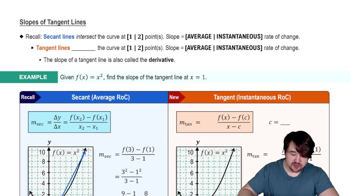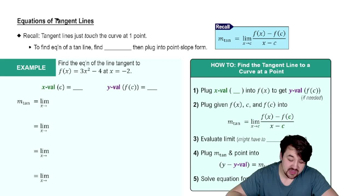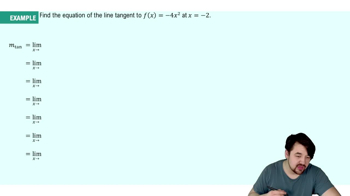Table of contents
- 0. Functions7h 52m
- Introduction to Functions16m
- Piecewise Functions10m
- Properties of Functions9m
- Common Functions1h 8m
- Transformations5m
- Combining Functions27m
- Exponent rules32m
- Exponential Functions28m
- Logarithmic Functions24m
- Properties of Logarithms34m
- Exponential & Logarithmic Equations35m
- Introduction to Trigonometric Functions38m
- Graphs of Trigonometric Functions44m
- Trigonometric Identities47m
- Inverse Trigonometric Functions48m
- 1. Limits and Continuity2h 2m
- 2. Intro to Derivatives1h 33m
- 3. Techniques of Differentiation3h 18m
- 4. Applications of Derivatives2h 38m
- 5. Graphical Applications of Derivatives6h 2m
- 6. Derivatives of Inverse, Exponential, & Logarithmic Functions2h 37m
- 7. Antiderivatives & Indefinite Integrals1h 26m
2. Intro to Derivatives
Tangent Lines and Derivatives
Problem 3.1.14
Textbook Question
A projectile is fired vertically upward into the air; its position (in feet) above the ground after t seconds is given by the function s (t). For the following functions, use limits to determine the instantaneous velocity of the projectile at t = a seconds for the given value of a.
s(t) = -16t2 + 128t + 192; a = 2
 Verified step by step guidance
Verified step by step guidance1
Step 1: Understand that the instantaneous velocity of the projectile at time t = a is given by the derivative of the position function s(t) evaluated at t = a. This is because the derivative of a position function with respect to time gives the velocity function.
Step 2: The position function is s(t) = -16t^2 + 128t + 192. To find the instantaneous velocity, we need to find the derivative of s(t) with respect to t, which is denoted as s'(t).
Step 3: Differentiate the function s(t) = -16t^2 + 128t + 192. Use the power rule for differentiation: if f(t) = at^n, then f'(t) = n*at^(n-1). Apply this rule to each term in s(t).
Step 4: After differentiating, you will obtain s'(t) = -32t + 128. This is the velocity function, which gives the velocity of the projectile at any time t.
Step 5: Evaluate the velocity function s'(t) at t = a, where a = 2. Substitute t = 2 into s'(t) to find the instantaneous velocity at that specific time.
Recommended similar problem, with video answer:
 Verified Solution
Verified SolutionThis video solution was recommended by our tutors as helpful for the problem above
Video duration:
4mPlay a video:
Was this helpful?

 5:13m
5:13mWatch next
Master Slopes of Tangent Lines with a bite sized video explanation from Nick
Start learningRelated Videos
Related Practice




